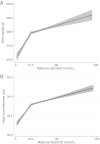Maternal serum 25-hydroxyvitamin D and measures of newborn and placental weight in a U.S. multicenter cohort study
- PMID: 23162094
- PMCID: PMC3537090
- DOI: 10.1210/jc.2012-3275
Maternal serum 25-hydroxyvitamin D and measures of newborn and placental weight in a U.S. multicenter cohort study
Abstract
Context: Inconsistent associations between maternal vitamin D status and fetal size have been published in small studies.
Objective: Our objective was to examine the association between maternal 25-hydroxyvitamin D [25(OH)D] levels and measures of newborn and placental weight.
Design and setting: We measured maternal 25(OH)D in mothers from the Collaborative Perinatal Project, an observational cohort conducted in 12 U.S. medical centers from 1959 to 1965.
Participants: Women delivering singleton, term, live births with 25(OH)D measured at a gestation of 26 wk or less (n = 2146).
Main outcome measures: Birth weight, ponderal index, placental weight, the placental to fetal weight ratio, and small for gestational age were measured. Hypotheses were formulated after data collection.
Results: After confounder adjustment, mothers with 25(OH)D of 37.5 nmol/liter or greater gave birth to newborns with 46 g [95% confidence interval (CI), 9-82 g] higher birth weights and 0.13 cm (0.01-0.25 cm) larger head circumferences compared with mothers with less than 37.5 nmol/liter. Birth weight and head circumference rose with increasing 25(OH)D up to 37.5 nmol/liter and then leveled off (P < 0.05). No association was observed between 25(OH)D and ponderal index, placental weight, or the placental to fetal weight ratio. Maternal 25(OH)D of 37.5 nmol/liter or greater vs. less than 37.5 nmol/liter in the first trimester was associated with half the risk of small for gestational age (adjusted odds ratio 0.5; 95% CI 0.3-0.9), but no second-trimester association was observed.
Conclusions: Maternal vitamin D status is independently associated with markers of physiological and pathological growth in term infants. Adequately powered randomized controlled trials are needed to test whether maternal vitamin D supplementation may improve fetal growth.
Figures

Similar articles
-
Maternal early pregnancy vitamin D status in relation to low birth weight and small-for-gestational-age offspring.J Steroid Biochem Mol Biol. 2018 Jan;175:146-150. doi: 10.1016/j.jsbmb.2017.09.010. Epub 2017 Sep 20. J Steroid Biochem Mol Biol. 2018. PMID: 28939424
-
Maternal serum 25-hydroxyvitamin D and placental vascular pathology in a multicenter US cohort.Am J Clin Nutr. 2013 Aug;98(2):383-8. doi: 10.3945/ajcn.112.055426. Epub 2013 Jun 26. Am J Clin Nutr. 2013. PMID: 23803889 Free PMC article.
-
Maternal vitamin D status, gestational diabetes and infant birth size.BMC Pregnancy Childbirth. 2017 Dec 15;17(1):420. doi: 10.1186/s12884-017-1600-5. BMC Pregnancy Childbirth. 2017. PMID: 29246128 Free PMC article.
-
Maternal vitamin D concentrations during pregnancy, fetal growth patterns, and risks of adverse birth outcomes.Am J Clin Nutr. 2016 Jun;103(6):1514-22. doi: 10.3945/ajcn.115.123752. Epub 2016 Apr 20. Am J Clin Nutr. 2016. PMID: 27099250 Free PMC article.
-
Vitamin D Supplementation during Pregnancy: An Evidence Analysis Center Systematic Review and Meta-Analysis.J Acad Nutr Diet. 2020 May;120(5):898-924.e4. doi: 10.1016/j.jand.2019.07.002. Epub 2019 Oct 25. J Acad Nutr Diet. 2020. PMID: 31669079
Cited by
-
Umbilical Cord Serum 25-Hydroxyvitamin D Concentrations and Relation to Birthweight, Head Circumference and Infant Length at Age 14 Days.Paediatr Perinat Epidemiol. 2016 May;30(3):238-45. doi: 10.1111/ppe.12288. Epub 2016 Feb 24. Paediatr Perinat Epidemiol. 2016. PMID: 27038010 Free PMC article.
-
Regulation of calcitriol biosynthesis and activity: focus on gestational vitamin D deficiency and adverse pregnancy outcomes.Nutrients. 2015 Jan 9;7(1):443-80. doi: 10.3390/nu7010443. Nutrients. 2015. PMID: 25584965 Free PMC article. Review.
-
The relationship between maternal vitamin D status during third trimester of pregnancy and maternal and neonatal outcomes: A longitudinal study.Int J Reprod Biomed. 2019 Mar 3;17(1):33-40. doi: 10.18502/ijrm.v17i1.3818. eCollection 2019 Jan. Int J Reprod Biomed. 2019. PMID: 31435583 Free PMC article.
-
Investigation of relationship between vitamin D status and reproductive fitness in Scottish hill sheep.Sci Rep. 2019 Feb 4;9(1):1162. doi: 10.1038/s41598-018-37843-6. Sci Rep. 2019. PMID: 30718917 Free PMC article.
-
The association of maternal vitamin D status with infant birth outcomes, postnatal growth and adiposity in the first 2 years of life in a multi-ethnic Asian population: the Growing Up in Singapore Towards healthy Outcomes (GUSTO) cohort study.Br J Nutr. 2016 Aug;116(4):621-31. doi: 10.1017/S0007114516000623. Epub 2016 Jun 24. Br J Nutr. 2016. PMID: 27339329 Free PMC article.
References
-
- Looker AC, Johnson CL, Lacher DA, Pfeiffer CM, Schleicher RL, Sempos CT. 2011. Vitamin D status: United States, 2001–2006. NCHS Data Brief 1–8 - PubMed
-
- van der Meer IM, Karamali NS, Boeke AJ, Lips P, Middelkoop BJ, Verhoeven I, Wuister JD. 2006. High prevalence of vitamin D deficiency in pregnant non-Western women in The Hague, Netherlands. Am J Clin Nutr 84:350–353; quiz 468–469 - PubMed
-
- Sachan A, Gupta R, Das V, Agarwal A, Awasthi PK, Bhatia V. 2005. High prevalence of vitamin D deficiency among pregnant women and their newborns in northern India. Am J Clin Nutr 81:1060–1064 - PubMed
-
- Holick MF. 1987. Photosynthesis of vitamin D in the skin: effect of environmental and life-style variables. Fed Proc 46:1876–1882 - PubMed
-
- Moore CE, Murphy MM, Holick MF. 2005. Vitamin D intakes by children and adults in the United States differ among ethnic groups. J Nutr 135:2478–2485 - PubMed
Publication types
MeSH terms
Substances
Grants and funding
LinkOut - more resources
Full Text Sources
Other Literature Sources
Medical

